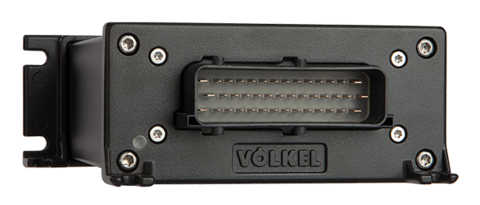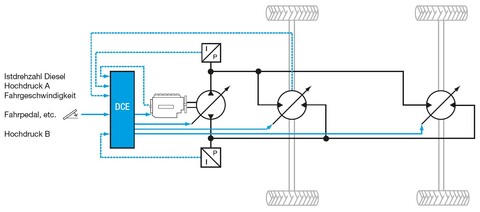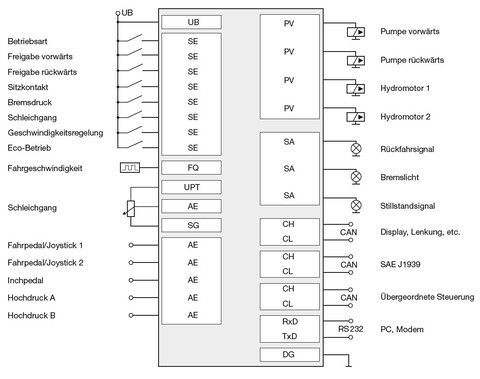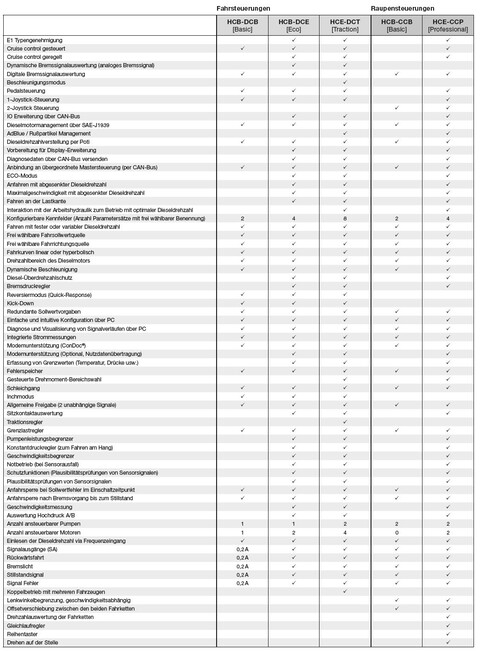
The advanced drive control DCE was developed for vehicles that are expected to offer a higher level of comfort. This includes municipal machinery, agricultural, forestry and construction machinery and many more. Here, the driver is to be relieved of operating the driving functions so that he can focus on the actual work. The DCE therefore features all the functions of basic drive control and numerous controls that can be activated as required.



The HCB controller is the standard hardware platform for the DCE. If the DCE is to be integrated into a machine controller, it can easily be ported to another Völkel hardware platform.
The comfort functions in detail
Velocity control
When the velocity control is activated with a button, the current driving velocity is stored. It serves as a setpoint for the controller, which acts on the diesel engine, the variable displacement pump and the variable displacement motor. In this way, the velocity is controlled in a closed loop and kept constant within the physical limits regardless of the terrain profile. When the accelerator pedal is operated while the velocity controller is active, its value has priority over the setpoint of the velocity controller, provided the setpoint of the accelerator pedal is greater. If the accelerator pedal is released, the setpoint for the traction drive returns to the stored value. Velocity control can be deactivated by pressing the button again or by applying the brake.
Constant pressure control
In hydrostatic traction drives, high velocities are achieved by reducing the hydraulic motor displacement. This measure has the effect of increasing the oil pressure required to accelerate the vehicle. If the machine travels uphill, the pressure may exceed a permissible value and the tractive force may drop depending on the travel velocity. The constant pressure control increases the torque of the hydraulic motor by increasing its displacement. As a result, the pressure is not built up any further, the machine slows down but the tractive force is maintained.
Brake pressure control
The brake pressure controller ensures continuous deceleration throughout the braking process. The braking process is recorded by pressure sensors, and the adjustment times of the hydraulic pump and the hydraulic motor are modified depending on the braking pressure and the displacement of the hydraulic motor. To create a smooth stop, the deceleration can be extended in the lower velocity range. The brake pressure controller can also help prevent unwanted shocks and noise during deceleration.
Diesel engine overspeed protection
The overspeed controller protects the diesel engine from excessive speed during hydrostatic deceleration (coasting). If the diesel engine speed increases to the set speed limit range, the braking power is reduced via the hydrostat adjustment. The overspeed controller has similar characteristics to the brake pressure controller: If no pressure sensors are present, a similarly continuous delay can be created using this controller. However, it is then dependent on the supporting torque of the diesel engine.
ECO operation
Modern diesel engines require operation with a high load at the operating point so that the exhaust gas aftertreatment functions efficiently. The DCE therefore enables starting with lowered diesel engine speed and driving the machine at the load edge of the diesel engine. If the drive pump is oversized with regard to the required driving performance, the drive train can be operated at the operating point of optimal efficiency – and the machine also reaches its maximum velocity with lowered diesel engine speed. Maximum power is requested only if the operating conditions require it.
E1 type approval
In order to enable registration of the machine for European road traffic, the hardware platform of the DCE controller has an E1 type approval.
Extended inputs and outputs
Extended inputs and outputs can be read via the CAN interface.